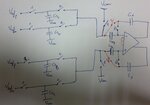ruby1212
Junior Member level 3

Hello all,
I am designing a circuit which uses a switched capacitor integrator,
The problem is that the desired output is very sensible to the dc offset of the amplifier,
I have been searching for offset-compensated SC integrator topologies....Apparently each compensates more or less offset and has its drawbacks..
One of you has ever tried a certain configuration that proved efficient ?
Does anybody still using integrators without offset cancellation ? Offset cancellation schemes are always taken into consideration ??
Thanks in advance for your answers!!
I am designing a circuit which uses a switched capacitor integrator,
The problem is that the desired output is very sensible to the dc offset of the amplifier,
I have been searching for offset-compensated SC integrator topologies....Apparently each compensates more or less offset and has its drawbacks..
One of you has ever tried a certain configuration that proved efficient ?
Does anybody still using integrators without offset cancellation ? Offset cancellation schemes are always taken into consideration ??
Thanks in advance for your answers!!




